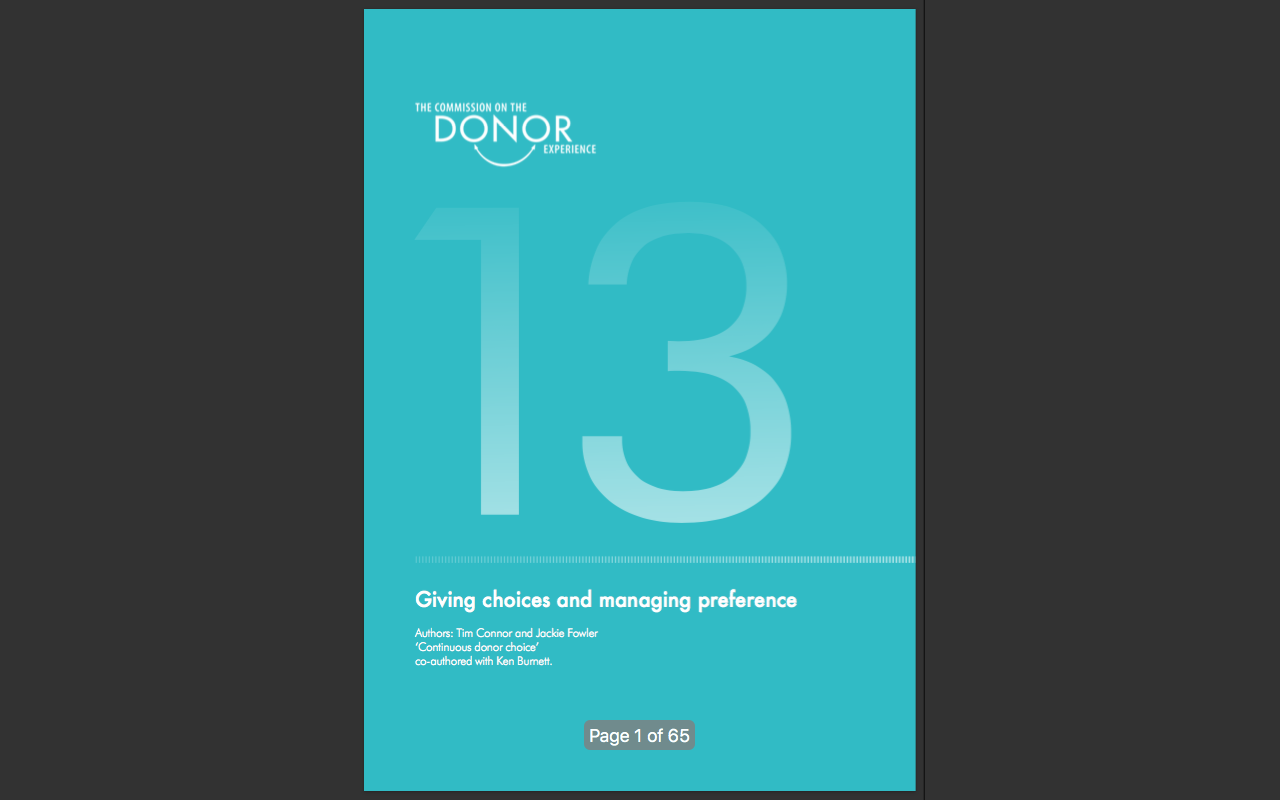CDE project 13 section 4: commercial examples of managing preferences
- Written by
- The Commission on the Donor Experience
- Added
- April 26, 2017
Commercial examples of managing preferences
In the theory we went through the case in favour of offering donors preferences, how it can reap benefits for your ongoing relationship and – as part of a donor-focussed charity strategy – can improve lifetime value.
Be in it for the long haul
It’s best to view preferences as something of a moving target. People may well state their choices at specific points in time – when signing up, for example - but it’s best to look at the process cumulatively.
Think of it as layering donor information over time. You don’t learn everything about a person on the first date. You meet a second time, then a third time. And gradually build up a picture of that person – what they believe in, what interests them, how they like to be treated.
The same principle applies for preferences. In the technical speak of ‘preference centres’ – a tool that helps you to capture digital preferences – this drip-by-drip approach is called ‘progressive profiling’. This approach was largely pioneered by the ‘marketing platform’ Silverpop - a system that captures information about the customer from multiple touchpoints to help tailor a more personalised experience.
As Loren McDonald from Silverpop explains, “It gives you multiple chances to build that trust and show them the quality of content they can expect from you.”
The visual below, taken from Rogare’s Relationship Fundraising research, shows the difference this approach can make to your business, moving from a transactional mindset to a relationship-driven one:

Getting the technical support you need
We, as a sector have much we can learn from the excellent work Silverpop and other preference centre champions have implemented in recent years. Whilst the examples we will look through in this section refer largely to email, the approaches translate across all channels.
As charities, we need to be looking at preferences and choices across every touch-point – offline and on. It is beyond the remit of this project to detail the ins and outs of the technical setup required to enable this type of data collection but our section on ‘Recommended Vendors’ gives options for one-man band charities through to nationally recognised organisations to get the technical support needed.
As this section demonstrates, it is the principle that matters. How donors are managed can be as simple as an Excel spreadsheet manually inputted. What matters is the experience of being listened to and having the request recognised. The scale of preferences and choices you offer will naturally vary based on what is feasible for each charity to manage. Indeed, an email address or telephone number to a human being at a charity is enough to provide trust and reassurance to a donor.
If they wish to change their communication relationship with you, you must ensure there is an easy and straightforward way for them to do so. Anything above and beyond that in terms of technical complexity is a plus, not a necessity.
In the examples that follow, pay particular attention to they ways these preferences are presented: see how they appeal to audience motivations and how they also aim to make the process easy to do.
Let’s start by looking at the different touch-points where people are likely to provide you with their preferences.
Where and when are preferences captured?
At the start of the relationship
When signing up. In addition to collecting basic contact details, you may choose to offer different content up front (e.g. newsletter vs. promotions), or levels of frequency (e.g. weekly vs. monthly vs. annually). These are the options people will choose based on the expectations you set in your offering; they have yet to experience what it may be like on the receiving end of your materials.
During the relationship
At any point along the journey they may click through to their preferences page and update their details. Perhaps they have changed address. If a commercial customer, perhaps they no longer wish to receive your daily deals, just the monthly offers. Something in their circumstances will have shifted and, in turn, they wish to adjust the communications relationship with you to reflect that.
At the end of the relationship
Perhaps you’ve been spamming them and they’ve gone to unsubscribe (64 per cent of consumers opt-out due to receiving email too frequently, as reported online by Marketing Sherpa). Perhaps they have moved into a different lifestage and your product or service is no longer relevant to them. Whatever the reason, you will come to the end of the road with some people. When they come to unsubscribe, some may leave a comment to tell you why. But for
many, they already have one foot out the door. You simply have to make it quick and simple for them to say farewell.
As we discussed in Part Two, preferences are just one part of the bigger picture concerning supporter data and how you can be more relevant to your supporter base. Richard Evans from Silverpop summarises this neatly in the visual below:
3 forms of data that drive dialogue


What does this teach us?
Contrary to where we might typically start to think about preferences (at the start of a relationship), we actually need to be several steps ahead of the supporter. We need to start from the end and work backwards. Ask yourself, what does the end look like?
Offering the right match of choices for people to select is how you, eventually, can make sure fewer people leave you. You have the best possible chance of staying relevant when people have continuous opportunities to tinker with their preferences as their needs and circumstances evolve over time.
But what if you are a small charity? What if you don’t have a set of choices as long as your arm to offer supporters? You might be a one-man or woman band fundraiser with limited tech. Does that mean all this talk of preferences doesn’t apply to you?
Absolutely not. Because preferences are not about the tech, they are about the principle. The principle of listening. Providing donors with a way to feedback. If that means penning a personal email to an individual at the charity then so be it. A simple operation like this is as valid as the most sophisticated form of automated profiling and data-driven communications.
What matters is that you are showing donors that how they feel and the choices they make matter. And that what they feedback will be taken on board and responded to. Donors simply want to be heard. You must meet whatever expectations you set and be true to what you have promised to do.
That is critical to any kind of data exchange – “growth through trust”, as referred to by consultancy Ctrl Shift. And with the new General Data Protection Regulation (GDPR) due to come into effect in May 2018, the use of personal data will more strictly regulated, and how we manage and use our donors’ data will become even more important.
Let’s take a look at a preference centre example
This example by DiscountTheatre.com wouldn’t win any DMA awards for creativity. But it does make a good fist of addressing customer motivation and ease, the two requirements to spur potential audiences to action.
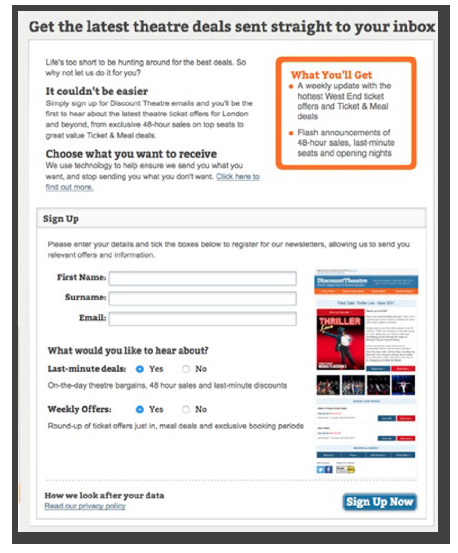
The headline.
Offers a ‘self-interest’ benefit. You don’t need to go browsing for the offers, we’ll send them straight to you as soon as they are out. We’ll do that leg-work, you just need to fill in some basic contact details.
Introductory copy.
Expands further on the key benefit, by starting where the potential customer is at - their motivations. They’d like deals but life is too short to be hunting around for the best ones. Fear not, we do that for you and send them on directly. Not only that, if you tell us a little bit more about what you would like to receive, you’ll get the most relevant offers to you.
What you’ll get.
Here they are setting out their stall. The prospect knows they are signing up for offers. But there’s an element of risk here. Can they trust you? What if this turns into an unwanted irritation, with emails relentlessly cluttering up your inbox every day?
Instead, it’s really specific – one update a week and any flash offers that come in. This is a smart decision because it sets out the structure of the email relationship, but still allows the company to send ad-hoc messages with additional content that is relevant and beyond the usual tranche of communications.
Contact fields.
Note how only three details are requested. Name (in order to personalise ‘Dear AB Sample’), and email address. If these communications lead to a sale, address details and the like will be populated in time. Or a progressive approach to the data capture could be taken, gradually adding details cumulatively during future interactions. But customers will evaluate how much data they give (and how much effort you are asking of them at a point in time), based on what it’s worth to them. No one will fill in a page and half of fields to get a ticket newsletter; a bank loan on the other hand is a different matter.
What would you like to hear about?
Too often this type of question is framed from a company’s perspective, particularly where charities are concerned. You more commonly see ‘Would you like us to… May we get in touch with you about etc…’? Remember, it’s not about you, it’s about them and the cause. You are merely the conduit. And in this example, there are two simple Yes/No options regarding content and frequency.
Example email.
A direct marketing approach as old as the hills. Don’t tell me, show me. Get me excited about what you are going to add to my life simply by giving you these few bits of my data. This is where emotion gets in (for those who, like the authors, grew up on the ‘Attention, Interest, Desire, Conviction, Action’ - or ‘AIDCA’ - model, this is the ‘conviction’ step in the process). But in the case of this product – theatre experiences – it’s also a chance to engage the emotions. Help me imagine myself already signed up to a email relationship with you. Give me a taster of what that will be like. It’s the principle of sales promotion in action: try before you buy.
How we look after your data.
Further reassurance that you are engaging with a trustworthy organisation (note also the nice detail in the example email, where a very positive Feefo customer satisfaction score is proudly displayed). This website is not a household name. Unsure users will want to know what they are letting their data in for.
The call to action
You are not asked to ‘Submit’. Your audiences are not computers. They are joining something. You are inviting them to something. And, in the tiniest and most subliminal of ways, adding ‘Now’ at the end adds a notch of urgency. Their decision could go either way at this critical moment. Cue them to take a positive action and become one of your prospects.
Here are five other good examples to learn from
Example 1: At the start of a relationship
This is another well structured way to start your relationship on the right foot, by setting expectations from the get-go and helping your audience understand how each piece of data will be used to fine-tune how you interact with them:
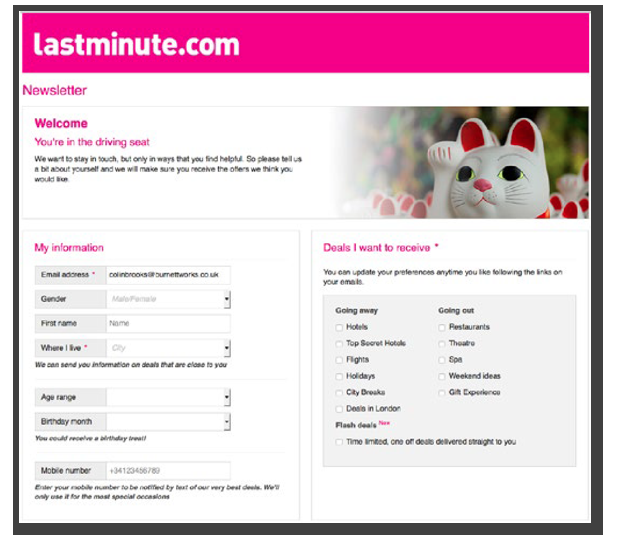
Example 2: Make it interesting
This example by DiscountTheatre.com wouldn’t win any DMA awards for creativity. But it does make a good fist of addressing customer motivation and ease, the two requirements to spur potential audiences to action.
When we talk about preferences, choices, control and all things data, it can be easy to think such things need to be dry and dull. Just extra fields on a form. But check out this lovely, visual approach to capturing interests from The Home Depot:
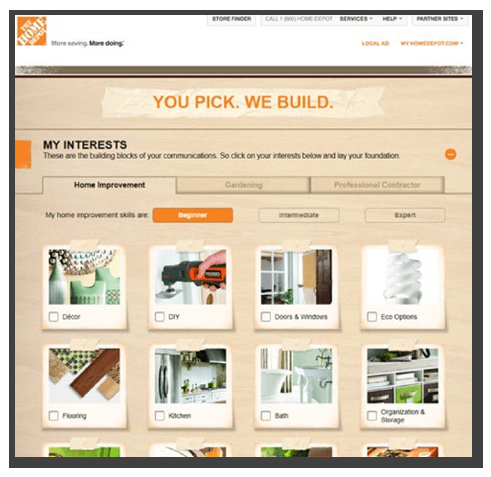
Example 3: During the relationship
This is a a well laid out preference page, created by Experian, that subscribers can click through to from any email they receive from Eastern Mountain Sports. From this page they can change how often they receive messages, update their data (excellent for cleansing your database) and even call time on the messages entirely.
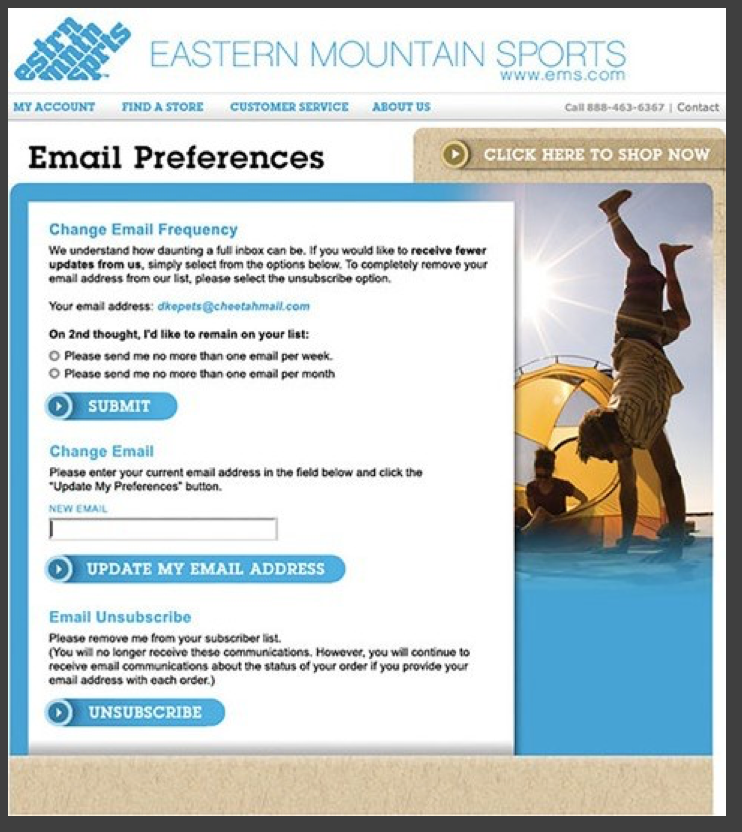
Example 4: At the end of the relationship
Here’s a good way to capture feedback on why people may choose not to let you stay in touch. You should keep a close eye on these stats. If, as many find, email frequency or message irrelevance keep coming out on top, you know you have more homework to do:

Example 5: And finally, a lovely extra touch…

When you sign up via the charity Solar Aid, on top of filling in your contact details you are asked one question: “Please tell us why you’re supporting the solar revolution”. The response is an open field.
Richard Turner, former head of fundraising at the charity, used to collate the text answers in this field and regularly send them round to senior management (a mark of a truly donor-led charity culture).
Why? Because connection to the cause matters. It’s a very personal thing. We need to understand why people are engaging with us, not just what they are requesting.
If someone is donating to a Parkinson’s charity because they have a parent who has recently been diagnosed, your next interaction with them will need to be very different from someone who has simply added you to their basket of good causes.
One may need help and support information, the other may be someone you can invite to volunteer. A ‘one size fits all’ letter or email appeal will not suffice. Charities in future must listen, be sensitive and be relevant. This is what well framed choices and benefit-driven preferences can add to the donor experience.
Conclusion
In this section we have surveyed how commercial organisations have been using preference centres as a means of putting customers in control of the data they give, the communications they receive and the closeness of relationship they are happy to have.
The principles on display here are entirely relevant to the charity sector, even more so as we trade in causes that people care passionately about. Sensitivity to such preferences – and coming good on the expectations we set – is paramount.



